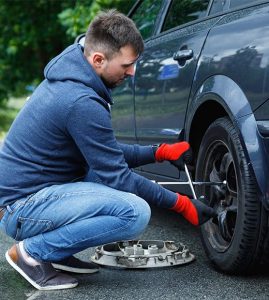Guide to Changing a Tire Like a Pro
How to Change a Flat Tire – Step by Step

So you’re driving along, not a care in the world, when all of a sudden the road gets a little bumpy. And lumpy. You’ve got a flat tire. What do you do?
Get Off the Road – Safely
First things first: you are going to want to pull over and find a safe place. The longer you drive on a flat tire, the more damage you are doing to your wheel, your axle, your alignment, and more. You are also increasing the likelihood of an accident. Your car can fishtail and swerve out of control if you continue trying to drive on a flat tire.
Getting Ready to Change a Tire
Once you’re in a safe location, you have to assess whether or not it’s safe to try and change the tire yourself. You need to consider:
- Is the ground stable? If it’s grass, or sand, or anything that isn’t 100% solid, you should not try to change your tire.
- Is the ground level? If the ground is uneven or hilly, it’s very dangerous to attempt to change your tire.
You also need to concern yourself with the traffic. If, for example, your tire blows out on the freeway, and you pull over to the shoulder, and there are cars zipping past, it’s risky to change your tire – especially if it’s on the left side of your car. You can set out traffic comes or flares if you have them, and they might provide you with enough space, but if you feel at all uncomfortable, you should call AAA or a tow truck.
Setting Up for Changing a Tire
If the ground is level and even, and you have plenty of room, you can move on to the next step.
- Put the car in Park
- Apply the parking brake
- Chock the tires with a rock or piece of wood
Take the jack out of your car (you have a jack in your car, right?) and place it under the frame close to the tire that needs replacing. Double check to ensure that the jack is going to make contact with the metal of the frame.
DO NOT PLACE YOURSELF UNDER THE CAR IN ANY WAY!
Raise the Car with the Car Jack
Raise up the jack until it is supporting – but not lifting – the car. The flat tire should still be touching the ground. This will give you the purchase needed to remove the lug nuts.
Pop the hub cap off, if it’s covering up the lug nuts, and then proceed to loosen them up. Don’t take them off completely yet.
This is also a good time to double check the stability of the car jack. Does it shimmy and shake when you’re removing the lug nuts? If so, lower the jack, readjust until it’s stable, and raise the car again.
Swap out the Flat Tire for the Spare
Once the lug nuts are loosened, raise the car jack until the flat tire is hovering slightly above the ground. Remove the lugs by hand, and putt off the flat. Place it under the car, so that if the car jack collapses, the car will fall onto the old wheel, and prevent an injury.
Next, slide the spare tire on, and hand-tighten the lug nuts. When they are no longer able to turn by hand, finish the job with your wrench.
- Tighten the lug nuts evenly and diagonally, rather than one at a time, to ensure that they are all equally tight.
Lower the jack until the spare tire is touching the ground, and give the lug nuts a final tightening.
Finishing Up
Lower the car all the way, and put the jack, wrench, and flat tire away. Replace the hubcap if you took it off. Drive to the mechanic and get the flat fixed or replaced. The mechanic should be able to put the repaired tire on for you, so you don’t have to get your hands dirty again.










